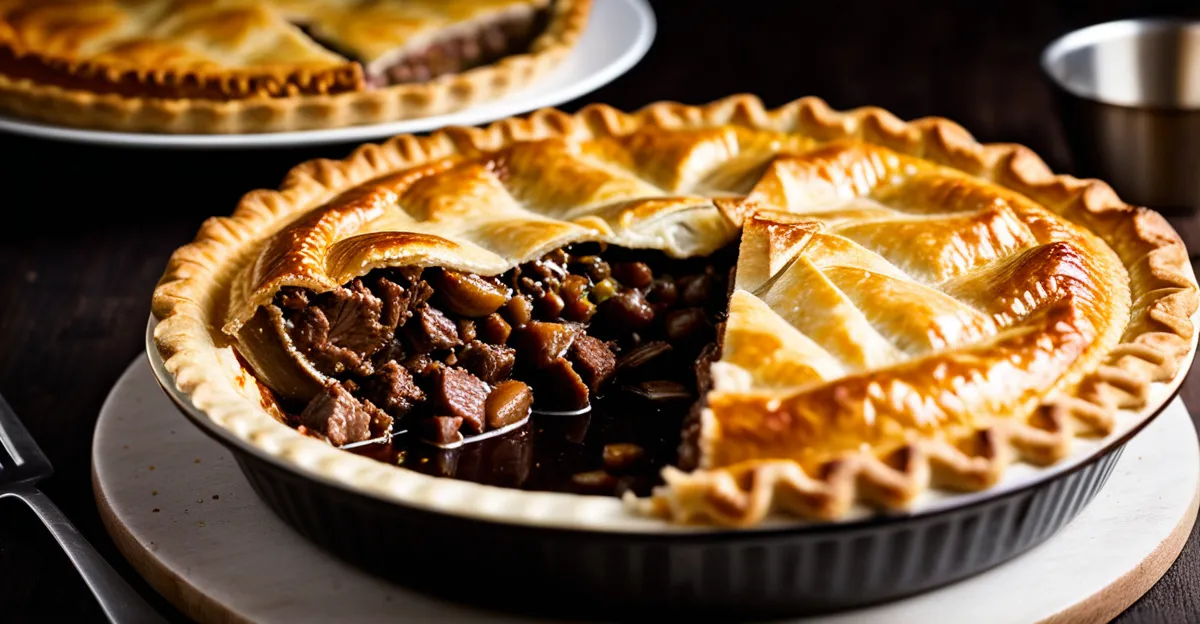Essential Ingredients and Tools for Steak and Kidney Pie
To create a classic steak and kidney pie, selecting the right steak and kidney is crucial. Opt for cuts like braising steak or chuck steak, which become tender and flavorful when slow-cooked. For the kidney, lamb or beef kidneys are preferred, offering a mild taste and tender texture once properly prepared. These steak and kidney pie ingredients ensure authenticity and richness.
Beyond meat, include onions, flour, suet or butter for the crust, and stock to develop a hearty filling. Traditional herbs like thyme and bay leaf elevate the classic flavour.
Also to discover : What are the unique flavors of regional UK sausages?
The right preparation tools make the process smooth. Essential equipment includes a heavy-based pan or casserole for slow cooking, a sharp knife for precise trimming, and suitable pie dishes for assembling. A rolling pin and pastry brush are vital for handling pastry.
Investing in these tools and selecting quality ingredients dramatically impacts the final dish, resulting in a tender, flavourful steak and kidney pie worthy of tradition.
Topic to read : How can you create a deliciously flaky Bakewell tart?
Preparing Tender Steak and Kidney
Tender steak and kidney are the heart of a classic steak and kidney pie, demanding careful preparation to achieve the ideal texture. Begin by trimming excess fat and sinew from the steak, then cut it into evenly sized pieces. For kidney preparation, removing the strong, sometimes bitter flavour is essential. Soak the kidney in cold water or milk for 30 minutes to an hour; this reduces any unwanted taste and improves tenderness.
Seasoning plays a vital role. Applying salt and freshly ground black pepper to the steak pieces before cooking enhances the natural flavours. Some cooks prefer a simple marinade with Worcestershire sauce or red wine, which tenderises the meat and adds depth.
When cooking, slow, gentle simmering breaks down tough fibres, ensuring juicy steak and kidney. Avoid overcooking early, as this can dry out the meat. These steak preparation tips and kidney preparation techniques guarantee a filling both succulent and flavourful, building the foundation for an outstanding pie every time.
Mastering Pastry for the Perfect Pie
Creating the ideal steak and kidney pie pastry requires mastering key techniques to ensure a golden, flaky crust. Start with choosing the right pastry type: shortcrust is sturdy and buttery, perfect for holding hearty fillings, while puff pastry offers a light, layered texture. Both work well, but preference depends on desired mouthfeel and appearance.
To achieve a flaky texture, keep ingredients cold and avoid overhandling the dough. Mixing cold butter into the flour in small, even pieces creates layers that puff during baking. Resting the dough in the fridge relaxes gluten, preventing toughness. When rolling out, use light, even pressure to maintain these layers.
Preventing soggy pastry is vital for a classic steak and kidney pie. Blind baking the base slightly before adding the filling helps seal the crust. Additionally, ensure your filling isn’t overly wet by simmering gently and thickening with a roux or flour.
For finishing touches, brush the pastry with egg wash for a shiny, golden finish. These flaky pastry tips safeguard the crust’s texture, harmonizing perfectly with the rich filling, elevating your pie from good to exceptional.
Assembling and Baking the Classic Steak and Kidney Pie
Successfully assembling steak and kidney pie is crucial for even cooking and flavour balance. Begin by layering the tender filling thoughtfully—place the meat mixture evenly in the pie dish, ensuring no large gaps that can cause uneven cooking. Avoid overfilling; this helps the crust bake properly without becoming soggy.
Managing the pie filling consistency is key. A filling too wet leads to a soggy base, while too dry results in a crumbly texture. Simmer the filling until thickened, using a roux or flour to achieve the ideal thickness. This ensures the filling is rich but not runny, delivering that coveted hearty bite.
For oven baking tips, preheat the oven to a moderate 180-190°C (350-375°F). Bake the pie for 45-60 minutes, or until the pastry turns golden brown and crisp. To test doneness, check the crust’s colour and firmness; a pale or soft crust signals underbaking. Tent the edges with foil if they brown too quickly to prevent burning while the filling cooks through.
Following these steps guarantees a well-cooked, satisfying classic steak and kidney pie with balanced flavours and textures.
Traditional Flavours and Enhancements
Achieving the signature taste in a classic steak and kidney pie depends heavily on the traditional steak and kidney pie flavours brought by carefully selected seasonings and herbs. Key aromatics include thyme, bay leaf, and freshly ground black pepper, which together create a robust, earthy foundation. These herbs infuse during slow cooking, melding into the rich filling for authentic depth.
Building a luscious gravy is essential. Incorporate beef or veal stock with a roux to thicken and intensify the sauce. A splash of Worcestershire sauce adds umami, elevating the savoury profile without overwhelming the natural meat flavours.
Variations in seasoning allow tailored nuances while respecting tradition. For example, a pinch of nutmeg or a dash of mustard powder can subtly enhance the complexity without detracting from the pie’s classic character.
By focusing on these seasoning variations and perfecting the gravy for pie, you enhance the filling’s richness, making every mouthful satisfyingly flavorful and true to classic British cuisine. Exploring these flavour layers invites cooks to both respect tradition and embrace personal taste preferences.
Avoiding Common Pitfalls
Mastering a classic steak and kidney pie means anticipating and avoiding frequent mistakes. One key steak and kidney pie mistake is using tough cuts or under-prepared kidneys, which results in chewy meat. Remedy this by choosing appropriate cuts and applying proper kidney preparation techniques such as soaking to remove bitterness and marinating to tenderise.
Another common problem is a bland filling. This often stems from insufficient seasoning or lack of robust herbs. Enhancing your filling with traditional aromatics like thyme and bay leaf ensures depth. Adjust seasoning gradually and taste as you cook to avoid this pitfall.
Pastry issues also plague many cooks. A soggy bottom crust usually indicates a too-wet filling or underbaking. Use flaky pastry tips like blind baking and thickening the filling with a roux to maintain crust integrity. Overhandling dough causes toughness; gently mix and chill pastry to prevent this.
When troubleshooting, remember these expert pie tips: maintain balance in filling moisture, monitor oven temperature closely, and don’t rush layering. This careful attention prevents common problems, helping you create a well-textured, flavorful, and visually appealing pie every time.






